ACC707 Audit Report: Green Machine Ltd. - Key Assertions & Procedures
VerifiedAdded on 2023/04/23
|6
|1586
|189
Report
AI Summary
This audit report analyzes the audit of Green Machine Ltd., a manufacturer, focusing on the property, plant, and equipment. The report identifies two key assertions at risk: proper classification between revenue and capital items, and the accuracy of depreciation calculations. Substantive audit procedures, including vouching of invoices, physical asset verification, and checking depreciation calculations, are proposed to address these risks. Furthermore, the report discusses the application of ASA 701, highlighting the communication of key audit matters in the auditor's report, specifically the classification of expenditure and depreciation rates. The report details the rationale behind this standard, emphasizing its role in enhancing the transparency and communicative value of the audit report, and includes the necessary disclosures for the Key Audit Matters section of the Auditor’s report.
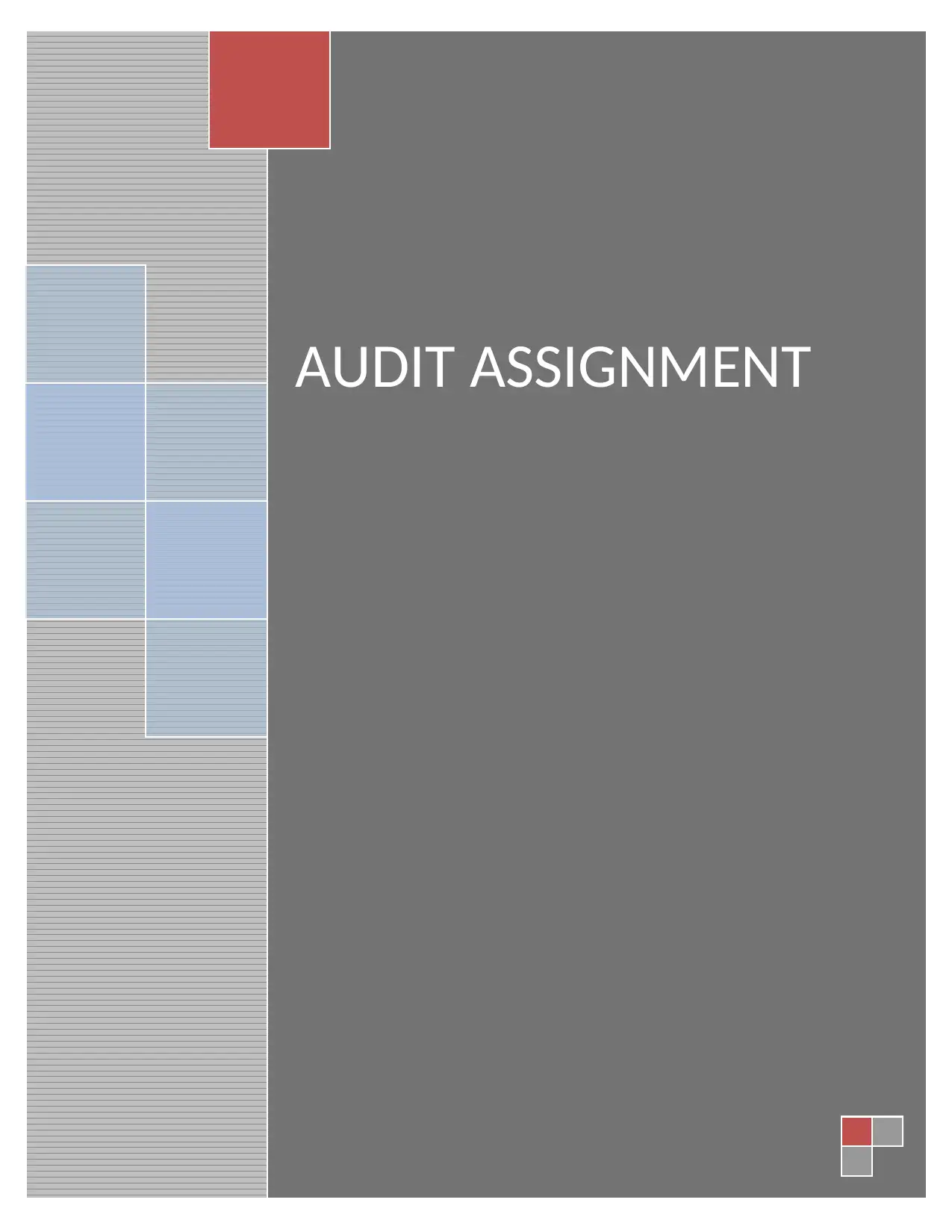
AUDIT ASSIGNMENT
Paraphrase This Document
Need a fresh take? Get an instant paraphrase of this document with our AI Paraphraser
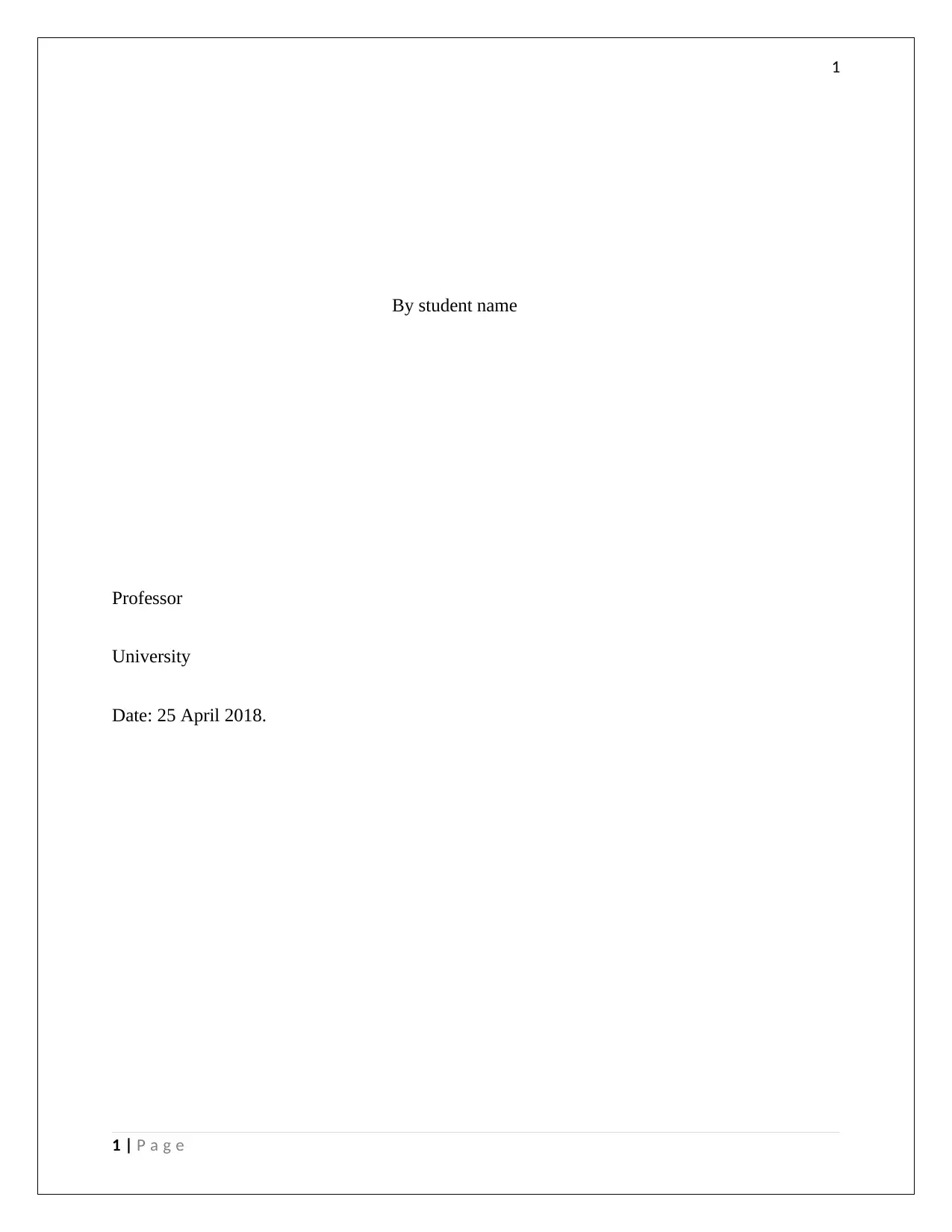
1
By student name
Professor
University
Date: 25 April 2018.
1 | P a g e
By student name
Professor
University
Date: 25 April 2018.
1 | P a g e
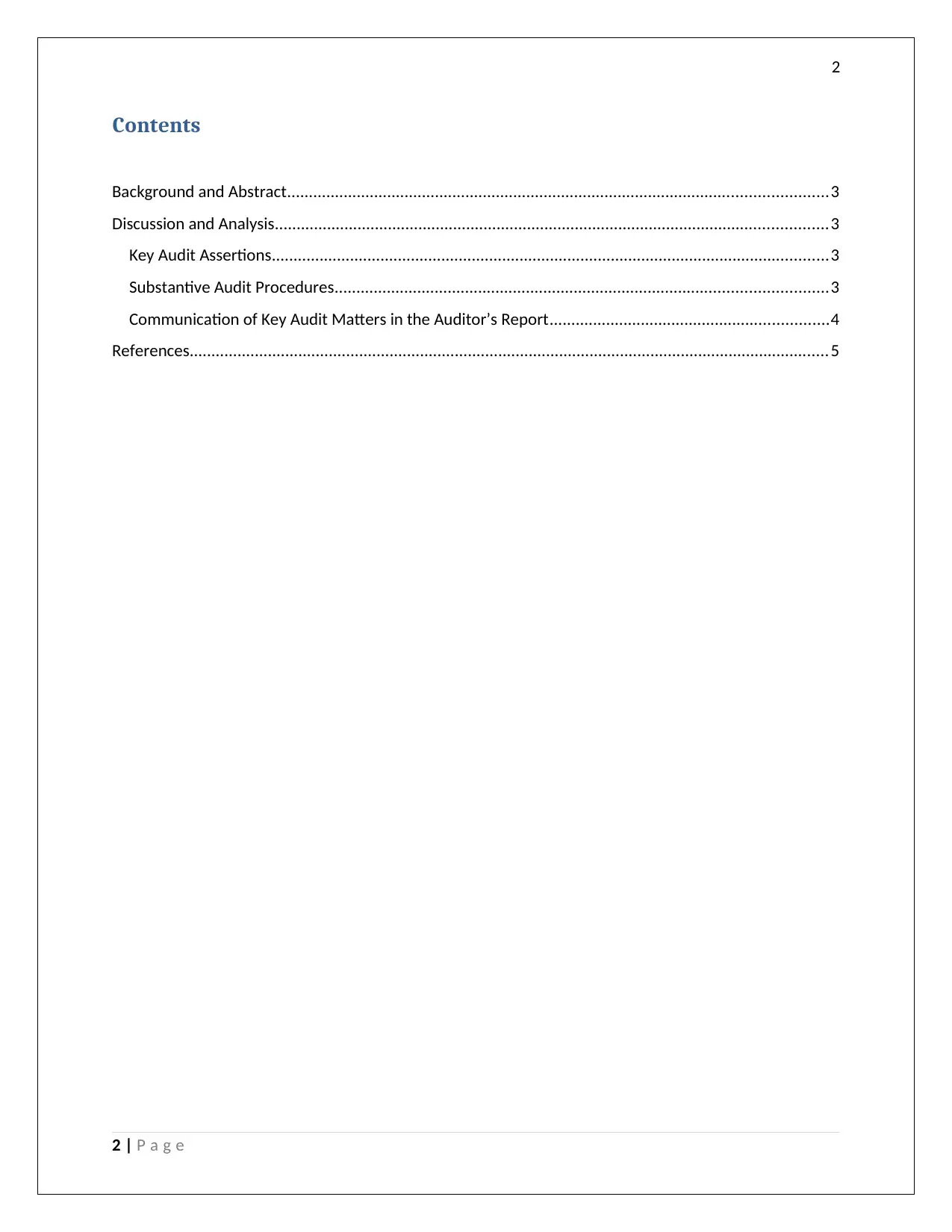
2
Contents
Background and Abstract............................................................................................................................3
Discussion and Analysis...............................................................................................................................3
Key Audit Assertions................................................................................................................................3
Substantive Audit Procedures.................................................................................................................3
Communication of Key Audit Matters in the Auditor’s Report................................................................4
References...................................................................................................................................................5
2 | P a g e
Contents
Background and Abstract............................................................................................................................3
Discussion and Analysis...............................................................................................................................3
Key Audit Assertions................................................................................................................................3
Substantive Audit Procedures.................................................................................................................3
Communication of Key Audit Matters in the Auditor’s Report................................................................4
References...................................................................................................................................................5
2 | P a g e
⊘ This is a preview!⊘
Do you want full access?
Subscribe today to unlock all pages.

Trusted by 1+ million students worldwide
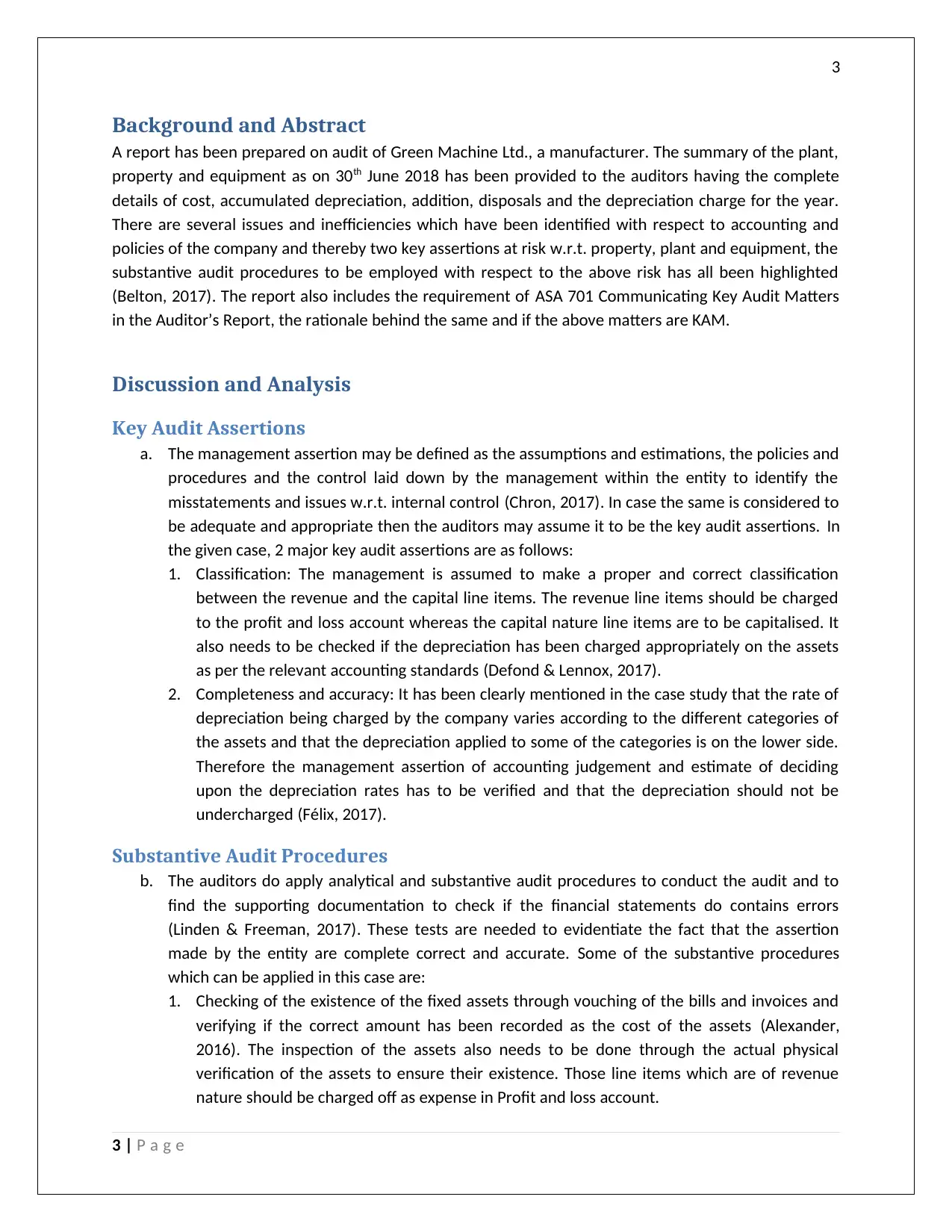
3
Background and Abstract
A report has been prepared on audit of Green Machine Ltd., a manufacturer. The summary of the plant,
property and equipment as on 30th June 2018 has been provided to the auditors having the complete
details of cost, accumulated depreciation, addition, disposals and the depreciation charge for the year.
There are several issues and inefficiencies which have been identified with respect to accounting and
policies of the company and thereby two key assertions at risk w.r.t. property, plant and equipment, the
substantive audit procedures to be employed with respect to the above risk has all been highlighted
(Belton, 2017). The report also includes the requirement of ASA 701 Communicating Key Audit Matters
in the Auditor’s Report, the rationale behind the same and if the above matters are KAM.
Discussion and Analysis
Key Audit Assertions
a. The management assertion may be defined as the assumptions and estimations, the policies and
procedures and the control laid down by the management within the entity to identify the
misstatements and issues w.r.t. internal control (Chron, 2017). In case the same is considered to
be adequate and appropriate then the auditors may assume it to be the key audit assertions. In
the given case, 2 major key audit assertions are as follows:
1. Classification: The management is assumed to make a proper and correct classification
between the revenue and the capital line items. The revenue line items should be charged
to the profit and loss account whereas the capital nature line items are to be capitalised. It
also needs to be checked if the depreciation has been charged appropriately on the assets
as per the relevant accounting standards (Defond & Lennox, 2017).
2. Completeness and accuracy: It has been clearly mentioned in the case study that the rate of
depreciation being charged by the company varies according to the different categories of
the assets and that the depreciation applied to some of the categories is on the lower side.
Therefore the management assertion of accounting judgement and estimate of deciding
upon the depreciation rates has to be verified and that the depreciation should not be
undercharged (Félix, 2017).
Substantive Audit Procedures
b. The auditors do apply analytical and substantive audit procedures to conduct the audit and to
find the supporting documentation to check if the financial statements do contains errors
(Linden & Freeman, 2017). These tests are needed to evidentiate the fact that the assertion
made by the entity are complete correct and accurate. Some of the substantive procedures
which can be applied in this case are:
1. Checking of the existence of the fixed assets through vouching of the bills and invoices and
verifying if the correct amount has been recorded as the cost of the assets (Alexander,
2016). The inspection of the assets also needs to be done through the actual physical
verification of the assets to ensure their existence. Those line items which are of revenue
nature should be charged off as expense in Profit and loss account.
3 | P a g e
Background and Abstract
A report has been prepared on audit of Green Machine Ltd., a manufacturer. The summary of the plant,
property and equipment as on 30th June 2018 has been provided to the auditors having the complete
details of cost, accumulated depreciation, addition, disposals and the depreciation charge for the year.
There are several issues and inefficiencies which have been identified with respect to accounting and
policies of the company and thereby two key assertions at risk w.r.t. property, plant and equipment, the
substantive audit procedures to be employed with respect to the above risk has all been highlighted
(Belton, 2017). The report also includes the requirement of ASA 701 Communicating Key Audit Matters
in the Auditor’s Report, the rationale behind the same and if the above matters are KAM.
Discussion and Analysis
Key Audit Assertions
a. The management assertion may be defined as the assumptions and estimations, the policies and
procedures and the control laid down by the management within the entity to identify the
misstatements and issues w.r.t. internal control (Chron, 2017). In case the same is considered to
be adequate and appropriate then the auditors may assume it to be the key audit assertions. In
the given case, 2 major key audit assertions are as follows:
1. Classification: The management is assumed to make a proper and correct classification
between the revenue and the capital line items. The revenue line items should be charged
to the profit and loss account whereas the capital nature line items are to be capitalised. It
also needs to be checked if the depreciation has been charged appropriately on the assets
as per the relevant accounting standards (Defond & Lennox, 2017).
2. Completeness and accuracy: It has been clearly mentioned in the case study that the rate of
depreciation being charged by the company varies according to the different categories of
the assets and that the depreciation applied to some of the categories is on the lower side.
Therefore the management assertion of accounting judgement and estimate of deciding
upon the depreciation rates has to be verified and that the depreciation should not be
undercharged (Félix, 2017).
Substantive Audit Procedures
b. The auditors do apply analytical and substantive audit procedures to conduct the audit and to
find the supporting documentation to check if the financial statements do contains errors
(Linden & Freeman, 2017). These tests are needed to evidentiate the fact that the assertion
made by the entity are complete correct and accurate. Some of the substantive procedures
which can be applied in this case are:
1. Checking of the existence of the fixed assets through vouching of the bills and invoices and
verifying if the correct amount has been recorded as the cost of the assets (Alexander,
2016). The inspection of the assets also needs to be done through the actual physical
verification of the assets to ensure their existence. Those line items which are of revenue
nature should be charged off as expense in Profit and loss account.
3 | P a g e
Paraphrase This Document
Need a fresh take? Get an instant paraphrase of this document with our AI Paraphraser

4
2. Furthermore the calculation of the depreciation and the accuracy with which the same has
been done also needs to be done to check if the depreciation has been correctly charged.
The depreciation rates being applied by the company needs to be in line with the industry
and other companies and also as per the law and regulations (Heminway, 2017). The same
can be verified through verification of the fixed assets schedule and the depreciation
schedule. The auditors also need to check if the company has followed the rules specified in
the accounting standards and whether they are reviewing all the asset classes for
impairment and changes in the depreciation rates year on year. All the management
estimates and the judgements in this regard needs to be understood and supported by
rationale by the management (Werner, 2017).
Communication of Key Audit Matters in the Auditor’s Report
c. ASA 701 deals with the Communication of Key Audit Matters in the Auditor’s Report. Key Aduit
Matters are those matters which in the knowledge of the auditor were the most significant in
the audit of the financial statements of the entity during the given period and has to be
communicated in the audit report (Jefferson, 2017). It is generally being chosen form the
matters communicated to those charged with governance. The auditors generally mention the
areas which needed significant audit attention and why the same was being considered
significant and what were the steps employed by the auditor in order to overcome the same
(Dichev, 2017). The purpose and rationale behind this accounting standard is to increase the
communicative value of the auditor report and to improve the level of transparency of the
audit. It gives additional information to the intended users of the financial statements which
helps them in better understanding of the content of audit report. It should not be
misinterpreted as the substitute of disclosures or the modified opinion of the auditor, etc. They
generally highlight the areas where chances of material misstatements were high, how the
auditor applied the professional judgement and the audit tests to check and verify the same and
what was its effect on the financial statements (Choy, 2018).
In the given case, the key audit matters is the classification of the expenditure in between
capital and revenue line items and the rates of depreciation being charged for the different
classes of the assets. The same has been selected as one of the key audit matters as it will have
a huge financial impact in case the categorization is not done correctly (Marques, 2018). This
may have the effect of shooting up the profitability in case expenses are capitalized and vice
versa in case the capital line items are charged as expenses. Similarly, the depreciation rates are
on the lower side and needs to be properly justified as the same is having the effect of
increasing the profitability. The disclosures which needs to be provided in this regard in Key
Audit Matters Section of the Auditor’s report as required under ASA 701 includes the
depreciation schedule, the justification of lower depreciation rates, the methods used by the
auditor to resolve the issue and the changes in the internal control or policies being suggested
by the auditor to the management of the company (Trieu, 2017).
4 | P a g e
2. Furthermore the calculation of the depreciation and the accuracy with which the same has
been done also needs to be done to check if the depreciation has been correctly charged.
The depreciation rates being applied by the company needs to be in line with the industry
and other companies and also as per the law and regulations (Heminway, 2017). The same
can be verified through verification of the fixed assets schedule and the depreciation
schedule. The auditors also need to check if the company has followed the rules specified in
the accounting standards and whether they are reviewing all the asset classes for
impairment and changes in the depreciation rates year on year. All the management
estimates and the judgements in this regard needs to be understood and supported by
rationale by the management (Werner, 2017).
Communication of Key Audit Matters in the Auditor’s Report
c. ASA 701 deals with the Communication of Key Audit Matters in the Auditor’s Report. Key Aduit
Matters are those matters which in the knowledge of the auditor were the most significant in
the audit of the financial statements of the entity during the given period and has to be
communicated in the audit report (Jefferson, 2017). It is generally being chosen form the
matters communicated to those charged with governance. The auditors generally mention the
areas which needed significant audit attention and why the same was being considered
significant and what were the steps employed by the auditor in order to overcome the same
(Dichev, 2017). The purpose and rationale behind this accounting standard is to increase the
communicative value of the auditor report and to improve the level of transparency of the
audit. It gives additional information to the intended users of the financial statements which
helps them in better understanding of the content of audit report. It should not be
misinterpreted as the substitute of disclosures or the modified opinion of the auditor, etc. They
generally highlight the areas where chances of material misstatements were high, how the
auditor applied the professional judgement and the audit tests to check and verify the same and
what was its effect on the financial statements (Choy, 2018).
In the given case, the key audit matters is the classification of the expenditure in between
capital and revenue line items and the rates of depreciation being charged for the different
classes of the assets. The same has been selected as one of the key audit matters as it will have
a huge financial impact in case the categorization is not done correctly (Marques, 2018). This
may have the effect of shooting up the profitability in case expenses are capitalized and vice
versa in case the capital line items are charged as expenses. Similarly, the depreciation rates are
on the lower side and needs to be properly justified as the same is having the effect of
increasing the profitability. The disclosures which needs to be provided in this regard in Key
Audit Matters Section of the Auditor’s report as required under ASA 701 includes the
depreciation schedule, the justification of lower depreciation rates, the methods used by the
auditor to resolve the issue and the changes in the internal control or policies being suggested
by the auditor to the management of the company (Trieu, 2017).
4 | P a g e
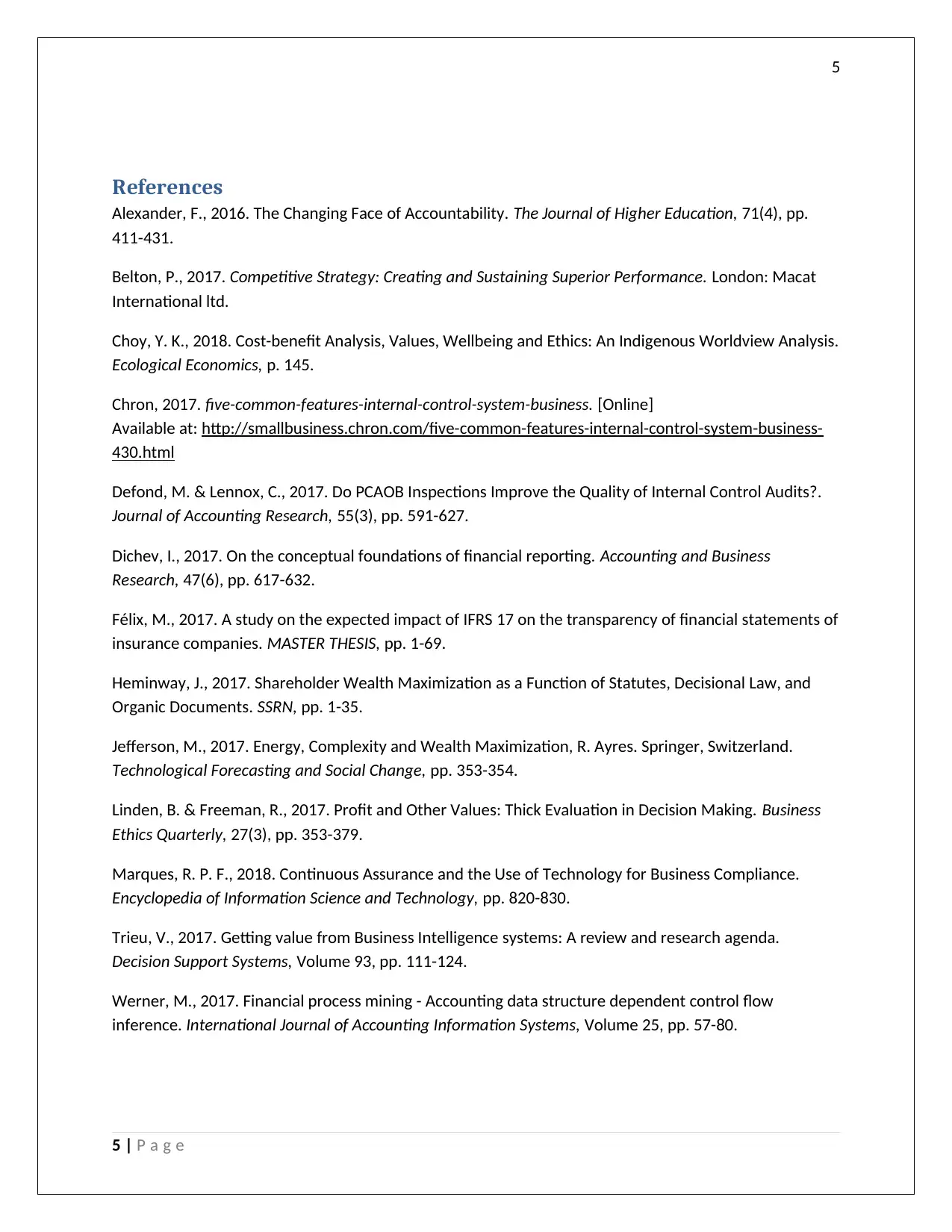
5
References
Alexander, F., 2016. The Changing Face of Accountability. The Journal of Higher Education, 71(4), pp.
411-431.
Belton, P., 2017. Competitive Strategy: Creating and Sustaining Superior Performance. London: Macat
International ltd.
Choy, Y. K., 2018. Cost-benefit Analysis, Values, Wellbeing and Ethics: An Indigenous Worldview Analysis.
Ecological Economics, p. 145.
Chron, 2017. five-common-features-internal-control-system-business. [Online]
Available at: http://smallbusiness.chron.com/five-common-features-internal-control-system-business-
430.html
Defond, M. & Lennox, C., 2017. Do PCAOB Inspections Improve the Quality of Internal Control Audits?.
Journal of Accounting Research, 55(3), pp. 591-627.
Dichev, I., 2017. On the conceptual foundations of financial reporting. Accounting and Business
Research, 47(6), pp. 617-632.
Félix, M., 2017. A study on the expected impact of IFRS 17 on the transparency of financial statements of
insurance companies. MASTER THESIS, pp. 1-69.
Heminway, J., 2017. Shareholder Wealth Maximization as a Function of Statutes, Decisional Law, and
Organic Documents. SSRN, pp. 1-35.
Jefferson, M., 2017. Energy, Complexity and Wealth Maximization, R. Ayres. Springer, Switzerland.
Technological Forecasting and Social Change, pp. 353-354.
Linden, B. & Freeman, R., 2017. Profit and Other Values: Thick Evaluation in Decision Making. Business
Ethics Quarterly, 27(3), pp. 353-379.
Marques, R. P. F., 2018. Continuous Assurance and the Use of Technology for Business Compliance.
Encyclopedia of Information Science and Technology, pp. 820-830.
Trieu, V., 2017. Getting value from Business Intelligence systems: A review and research agenda.
Decision Support Systems, Volume 93, pp. 111-124.
Werner, M., 2017. Financial process mining - Accounting data structure dependent control flow
inference. International Journal of Accounting Information Systems, Volume 25, pp. 57-80.
5 | P a g e
References
Alexander, F., 2016. The Changing Face of Accountability. The Journal of Higher Education, 71(4), pp.
411-431.
Belton, P., 2017. Competitive Strategy: Creating and Sustaining Superior Performance. London: Macat
International ltd.
Choy, Y. K., 2018. Cost-benefit Analysis, Values, Wellbeing and Ethics: An Indigenous Worldview Analysis.
Ecological Economics, p. 145.
Chron, 2017. five-common-features-internal-control-system-business. [Online]
Available at: http://smallbusiness.chron.com/five-common-features-internal-control-system-business-
430.html
Defond, M. & Lennox, C., 2017. Do PCAOB Inspections Improve the Quality of Internal Control Audits?.
Journal of Accounting Research, 55(3), pp. 591-627.
Dichev, I., 2017. On the conceptual foundations of financial reporting. Accounting and Business
Research, 47(6), pp. 617-632.
Félix, M., 2017. A study on the expected impact of IFRS 17 on the transparency of financial statements of
insurance companies. MASTER THESIS, pp. 1-69.
Heminway, J., 2017. Shareholder Wealth Maximization as a Function of Statutes, Decisional Law, and
Organic Documents. SSRN, pp. 1-35.
Jefferson, M., 2017. Energy, Complexity and Wealth Maximization, R. Ayres. Springer, Switzerland.
Technological Forecasting and Social Change, pp. 353-354.
Linden, B. & Freeman, R., 2017. Profit and Other Values: Thick Evaluation in Decision Making. Business
Ethics Quarterly, 27(3), pp. 353-379.
Marques, R. P. F., 2018. Continuous Assurance and the Use of Technology for Business Compliance.
Encyclopedia of Information Science and Technology, pp. 820-830.
Trieu, V., 2017. Getting value from Business Intelligence systems: A review and research agenda.
Decision Support Systems, Volume 93, pp. 111-124.
Werner, M., 2017. Financial process mining - Accounting data structure dependent control flow
inference. International Journal of Accounting Information Systems, Volume 25, pp. 57-80.
5 | P a g e
⊘ This is a preview!⊘
Do you want full access?
Subscribe today to unlock all pages.

Trusted by 1+ million students worldwide
1 out of 6
Related Documents
Your All-in-One AI-Powered Toolkit for Academic Success.
+13062052269
info@desklib.com
Available 24*7 on WhatsApp / Email
![[object Object]](/_next/static/media/star-bottom.7253800d.svg)
Unlock your academic potential
Copyright © 2020–2025 A2Z Services. All Rights Reserved. Developed and managed by ZUCOL.





